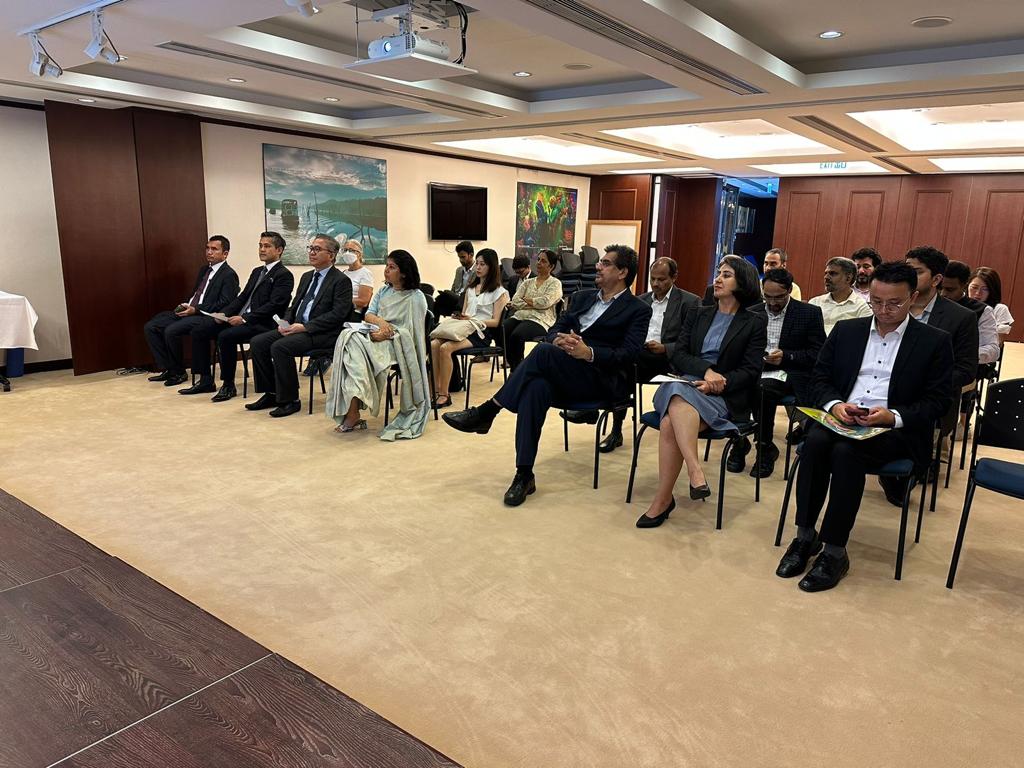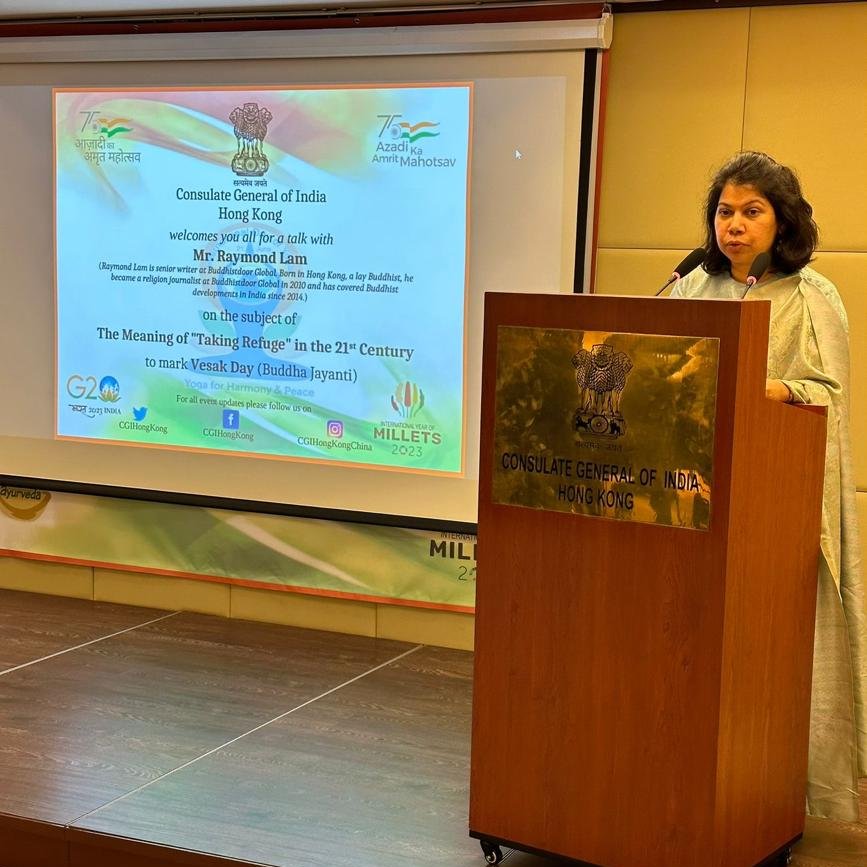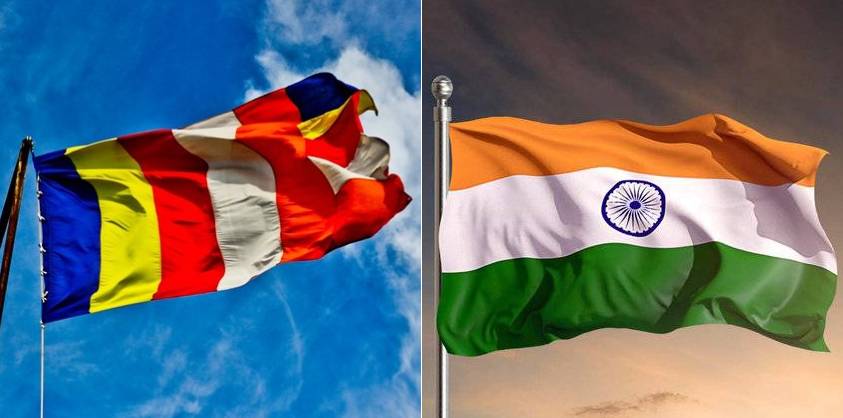This post is adapted from a speech that was given at the invitation of the Consulate of India, Hong Kong on 25 May, the eve of Vesak 2023 in the HKSAR and China.
Vesak celebrates the life of one of India’s great religious founders. While there is a considerable list of the philosophers and religious teachers that India has gifted the world, from Advaita Vedanta’s Sankara to Sikhism’s Guru Nanak, the Buddha and the spiritual tradition he founded ranks among India’s most transformative and momentous religious and cultural exports.
His life (and indeed, his past lives as recorded in the Jatakas) have been celebrated across Asia as the model human, both as teacher, and as leader in the form of the cakravartin or Wheel-Turning Monarch. This monarch’s insignia, envisaged by that estimable Indic king Ashoka the Great, even adorns the national flags of the great country of modern India.
On the eve of Vesak, it seems fitting to reflect on its significance in our time, in the 21st Century in a rapidly changing world that is headed in a direction that no one can predict for sure.

As the global Buddhist sasana celebrates the Buddha’s life once more, as it has done for over 2500 years, Planet Earth is in a far from ideal state. Geopolitical tensions threaten to tear Asia apart and envelop the world in war. The global economy faces severe problems that have made future prosperity a frankly unpredictable business. For the first time in human history, the younger generations are growing up in a 24-7 digital landscape and Internet culture that older caregivers are unprepared for.
This is a key node in the conversation. Technology, including the rapid ascent of AI in just the past year, is already transforming our lives and potentially what it even means to be human. Amidst all these rapid changes and existential questions, what does it mean to be fully human? Does a source of spiritual liberation and solace truly exist, away from all the Instagrammable suffering and futility?
Vesak is all about the core beats of the Buddha’s story: his birth, enlightenment, first sermon, and passing. He was born as Siddhartha Gautama in Lumbini, modern-day Nepal, to a noble clan called the Shakyas. A kind and compassionate prince, he lived a life of comfort and privilege until 29, when it is said that he snuck out of the palace and encountered the Four Sights: an old man, an ill man, a corpse, and then a wandering mendicant.

Deeply shaken by the reality of the world, he left his wife and infant son to practice asceticism until almost dying from over-taxing his body. Realizing that the Middle Way between the extremes of over-indulgence and self-torture was the way to liberation, he sat under a Bodhi Tree at Bodh Gaya, becoming enlightened and attaining the bliss of Nirvana at 35.
Through the attainment of Nirvana, Siddhartha Gautama became the Buddha. As this world’s historical Buddha, he would teach the Dharma, which encompasses the core doctrines of the Four Noble Truths and the Noble Eightfold Path. He expounded his teachings for the first time at present-day Varanasi, the Deer Park, his sermon heralding the first turning of the wheel of Dharma. When he died at 80 at modern-day Kushinagar, he left behind a great Sangha, or community of sanctity, that would reshape the spiritual landscape of Asia, from Southeast Asia to the Silk Road to right here in China and therefore the rest of East Asia.
Buddha, Dharma, and Sangha: they are what Buddhists call the three treasures, the heart of the Buddhist religion. At Vesak, Buddhists recite a threefold formula that they have memorized deep into their hearts: Buddham saranam gacchami, dhammam saranam gacchami, sangham saranam gacchami. Each is repeated three times, with the dutiyam and pattiyam declarations added successively. This is an ancient formula that dates all the way back to the Buddha’s life. When Buddhists recite this, whether for the first time as new practitioners or for the hundredth time at Buddha Jayanti, as millions will do tomorrow, they are saying something along the lines of,
“I recognize that wealth, power, and transitory pleasures cannot bring me existential liberation.”
“I seek insight about the reality of my life and the cosmos.”
“I accept that the three treasures provide the way to true happiness and freedom from the universe of death and rebirth.”
While not all of us will take refuge in the Buddha specifically, the idea of surrendering one’s ego and egocentric biases and pursuits is a relatable and desirable goal. Whether we take refuge in our chosen tradition or to an undefined idea of the transcendent, we know, deep in our hearts, that this world is fundamentally impermanent and unsatisfactory. We reify so many illusions and projections. We scramble over each other for wealth, status, job titles, that bigger home or flashier car, but as the COVID pandemic proved, our worldly aspirations can be so brittle, breakable, and easily swept away if we are unlucky.
Even when we do attain that which we think will make us happy – the position we’ve coveted and angled for, or a trip around the world, our rush fades away after a few months, and the emptiness that all human beings eventually feel inside grows. Even our closest ones – partners, family, friends – face the same problem, but we project unrealistic expectations that it’s their destiny, their job to make us happy, setting ourselves up for disappointment and anger when eventually, they don’t.
It is even more difficult for us in the contemporary world, surrounded by materialistic attractions, superficial allure, and 24-7 social media stimuli. More than ever, we all need a source of authentic refuge that can shelter us from the storm of life. For many this takes the form of a faith tradition. As a Mahayana Buddhist, I believe that all beings have the seed of Buddha Nature in them – the potential to awaken and be liberated. Others might be inspired by the teachings of Jesus, the story of Krishna, or many others.
On the eve of Vesak, we should explore the true meaning of this festival in our time, and take refuge in something that is truly lasting and true, enduring in its value, and offers true meaning to our lives.
It need not be a formal religious path, although that is one that I believe deeply can be transformative if it’s one that is tread sincerely. It can be as simple as refuge in ourselves – in our potential for awakening. We should have faith in our own ability or potential to be awakened to the deep and true reality of existence, to sincerely believe that our mind can be enlightened to our true nature.
The Buddha recognized this potential within himself. As our world faces challenges on all fronts, let courage and openness be the general refuge that we can all take. We should embrace the spiritual struggle in a world of superficiality and materialism, and make this struggle an art.


